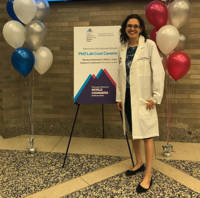For this year's Lasker Essay Contest, we asked medical, research, and public health trainees to tell us what the most important scientific lesson they learned from the Covid-19 pandemic was and how they will apply that lesson in their future work.
Since they wrote their essays in early 2021, a lot has happened: vaccines have become more widely available, many countries have begun lifting restrictions on how many people can work in research laboratories and more medical students are returning to patient care.
We caught up with our winners—Ziad Ali, Banafsheh Nazari, Miriam Saffern, Adina Schonbrun, and Trisha Pasricha—to see how they have been doing and to hear how life in July 2021 differs from January 2021. We asked them about their current work, what they've been reading lately, who inspires them, and, just for fun, what their favorite model organism is. We hope you enjoy getting to know our 2021 Lasker Essay Contest winners as much as we did.
Who is inspiring you as a scientist?
Ziad tells us about how Lasker Laureate Eric Kandel's autobiography inspired him to be less results-focused in his research, but rather, to use his work to search for truth.
What is your favorite model organism and why?
Ziad shares his admiration for Aplysia californica.
Can you tell us about your current experiment?
Learn about magnetic stimulation of neurons from Ziad.
Months later, would you still say that switching projects was the right move?
Ziad discusses what it was like to change his PhD project during the Covid-19 pandemic.
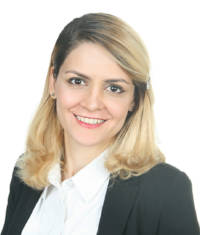
Banafsheh Nazari, Morehouse School of Medicine
What is your favorite model organism and why?
Banafsheh talks about the power of using organoids to study human disease.
Who is inspiring you as a scientist?
Banafsheh tells us about Maryam Mirzakhani, the first woman to win the Fields Medal.
What is the most important paper you have read recently?
Banafsheh discusses "The Rise of Intelligent Matter", a 2021 Nature paper by Kaspar et al.
What was your reaction to winning the 2021 Essay Contest?
Banafsheh thanks the Lasker Foundation for giving her a voice.
Trisha Pasricha, Massachusetts General Hospital
Essay One more question
What is the most interesting paper you read this week?
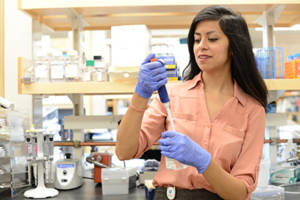
Trisha in the Laboratory
I just read a paper published by Mazumder et al. (1) in the June issue of Hepatology, which explores an important issue I have reflected on since the start of my medical training: black patients with cirrhosis have higher mortality and lower transplant rates. The process to receive liver transplantation in the United States is a fascinating case study of an attempt at a fair allocation of a rare resource (i.e.: a donated liver) that incorporates both objective and subjective input—with resulting discrepancies in distribution and policy across transplant centers nationally. You cannot treat end-stage liver patients without finding yourself grappling inwardly with the complex ethics of liver transplantation. This study quantified the unsettling observations that I and many [of my colleagues] have made in our years of training to become gastroenterologists. Like many other recent studies, this paper amplifies the need to investigate the drivers of racial disparities in health outcomes, including and, perhaps foremost, addressing our own racial bias within the medical system.
(1) Mazumder NR, Simpson D, Atiemo K, Jackson K, Zhao L, Daud A, Kho A, Gabra LG, Caicedo JC, Levitsky J, Ladner DP. Black Patients With Cirrhosis Have Higher Mortality and Lower Transplant Rates: Results From a Metropolitan Cohort Study. Hepatology, 2021 Jun 15, doi: 10.1002/hep.31742, online ahead of print.
Who inspires you as a scientist?
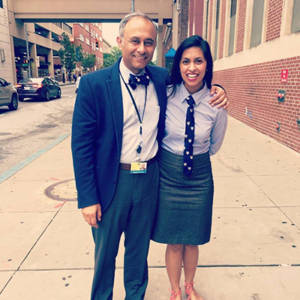
Trisha and her father, Pankaj Jay Pasricha
My favorite physician-scientist is my father, Pankaj Jay Pasricha, who is a Professor of Medicine at Johns Hopkins. He is actually a neurogastroenterologist and the reason I went into this field myself! I have never met anyone more passionate about their research, which he always grounds in his interactions with patients. He pioneered the treatment of what was then an untreatable and poorly understood condition in gastroenterology: achalasia, first with endoscopic botulinum toxin injections and later with per-oral endoscopic myotomy (POEM). He taught me how to use setbacks in scientific inquiry as a platform for more ingenuity and a framework for disruptive solutions to our patients' unmet needs.
What is your favorite model organism and why?
I love working with mice! I spent a year working at the NIH during medical school where I was trained in several murine models of gastrointestinal diseases. They allow us a highly versatile pre-clinical opportunity to explore novel hypotheses, which particularly through genetic manipulation such as the Cre-lox system, we cannot easily accomplish even in humans. I'm grateful for the chance to learn from them.

Trisha at Franconia Notch State Park
Did the patient you wrote about ever come back for the vaccine? How is that patient doing?
My patient finally did get vaccinated! I saw him in the clinic again this month, and I was sad to hear that several of his friends in his community had passed from Covid since I wrote this essay. He is otherwise doing relatively well and is starting to enjoy some of the freedoms afforded to those who are vaccinated.
Who inspires you as a scientist?
Miriam talks about two scientists who inpire her: 2020 Nobel Laureate Jennifer Doudna, and Miriam Merad, the head of the Precision Immunology Institute at Icahn School of Medicine at Mount Sinai.
Can you tell us about a paper you read recently and how it relates to your work?
Miriam tells us about her "wet lab" and "dry lab" work and about the 2018 Cell paper "Perspective on Oncogenic Processes at the End of the Beginning of Cancer Genomics" by Ding et al.
What is your favorite organism and why?
Miriam shares her love for the mouse, without which we would not understand many mechanisms of human immunology.
In your essay, you mention teaching virology to students. Can you talk about that?
Miriam tells us about two science outreach programs of which she is a part: the Scientist-in-Residence program through the New York Academy of Sciences Global STEM Alliance and an initiative that she started at Mount Sinai to reach high school students with the message that they, too, can go into STEM.
Adina Schonbrun, Memorial Sloan Kettering Cancer Center
Essay The Cornerstone of Scientific Success: Unsung Frontline Heroes of the COVID-19 Pandemic
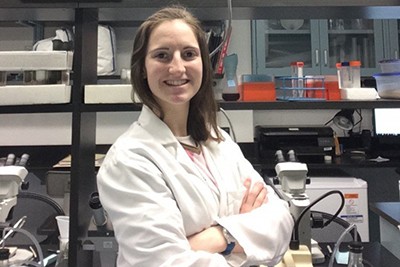
Adina in the fly lab
What is the most interesting paper that you read this week?
Adrian Salic's lab put out a very nice study on Sonic hedgehog (Shh) (1) binding partners. The study (2) showed that these binding partners essentially shuttle the dually lipidated Shh protein through the extracellular environment by shielding Shh's lipid attachments, in order to keep the protein soluble.
As part of my current project, I am investigating lipid substrate specificity for Hedgehog acyltransferase (Hhat), the enzyme that acylates Shh. Previous studies have found that Shh binds to its cell surface receptor, Patched, in part via its N-terminal acyl group. Adrian's study is interesting to me because it presents another protein-protein interaction among the initiating steps of the Shh pathway that is mediated by the acyl attachment on Shh, and therefore presents another facet as to why the acyl chain specificity might be important in activating the Shh pathway.
(1) Sonic hedgehog is a signaling molecule that is important for embryonic development.
(2) Wierzbowski et al., Vol 55:450-467, 2020.
What is your latest experiment?
My lab studies the membrane-bound O-acyltransferase, Hhat. I developed a new assay to monitor the activity of the Hhat, using fluorescence instead of radioactivity. My most recent experiments have been using this assay to determine how Hhat chooses which of the many fatty acids in cells will be attached to Shh and how this affects Shh signaling.

Sonic Hedgehog Pathway The Hedgehog signaling pathway is a cell-cell communication system critical for embryonic development and adult tissue homeostasis.
Shh: Sonic hedgehog (secreted signaling molecule); SHH-N: N-terminal signaling domain of Sonic hedgehog; DISP: Dispatched, sterol- sensing domain protein; PTCH: Patched receptor; SMO: Smoothened, G-protein coupled receptor; GLI: Glioma-associated oncogene homolog transcription factor
Who inspires you as a scientist?
Dr. John Golin, recently retired biology professor and principal investigator at The Catholic University of America, was my first real mentor. He inspired me to believe in myself, and [he worked] to turn the potential he saw in me as an intern in his lab into a career path. Dr. Golin inspired me to grow as a scientist, and I learned from him that believing in yourself is the first step to becoming successful. Dr. Golin continues to be a role model and supportive mentor to me to this day.
What is your favorite model organism and why?
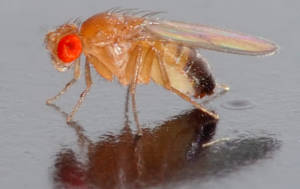
Drosophila melanogaster
Courtesy of André Karwath
I've worked with yeast, bacteria, and Drosophila melanogaster. I like Drosophila the best. In the fly lab in which I spent my post-bac year, my research called for dissecting the flies to study their reproductive systems. By doing so, I was constantly reminded how amazing it is that such a tiny organism, like a human, has reproductive organs, a digestive tract, and a circulatory system, and it can "fit" all of this and maintain all the complexities required of a living being to function.
What do you think is the best way to honor the unsung frontline workers?
The underlying issue I point to in my essay is that we often take other people for granted. I think a good place to start [is]… promoting greater mutual respect and understanding among people with different professions. We all need to remember that everyone is important and can contribute to society in a meaningful way.

